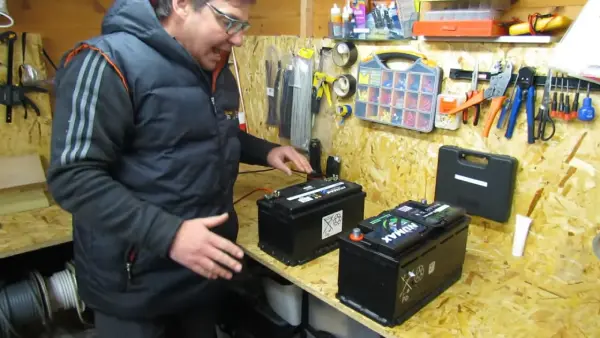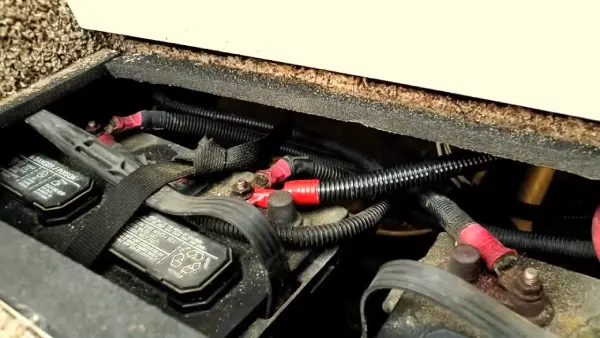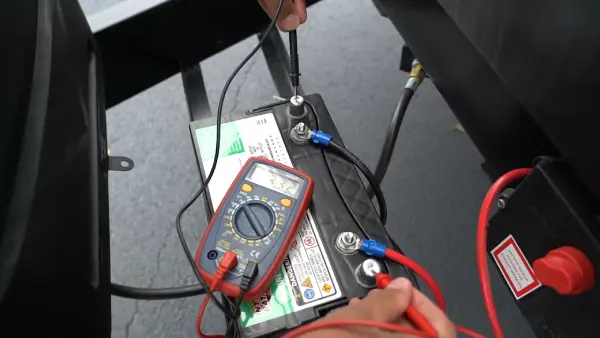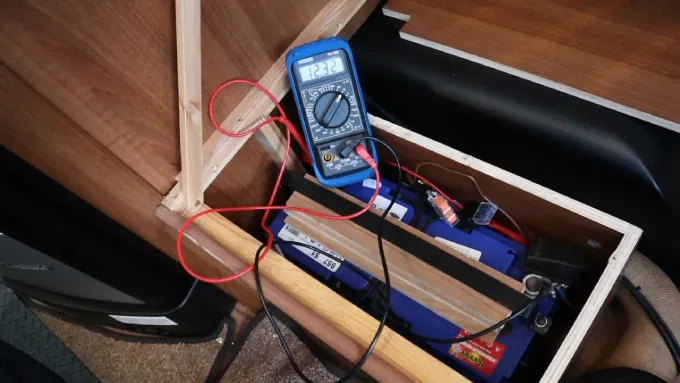Last Updated on May 4, 2023
A motorhome is perfect for those who love to travel and explore new places. It provides you with a home on wheels, allowing you to enjoy all the comforts of home while on the road.
But nothing can be more frustrating than finding out that your motorhome battery has gone flat while on a trip. You may wonder why this happens and what you can do to prevent it from happening in the future.
Several factors may contribute to a motorhome battery going flat. Parasitic drain, old or bad batteries, low charging voltage, and overuse of appliances are among the most common causes of battery drain.
Fortunately, there are several ways to prevent motorhome battery drain. Read on to find out all the possible causes of your motorhome battery going flat in detail, as well as some solutions to prevent your motorhome battery from going flat in the future.
Why Does My Motorhome Battery Go Flat: Common Causes

Motorhome batteries are essential for powering appliances and electrical systems in your vehicle. But it can be frustrating when you find that your battery is constantly going flat. You should be aware of several common causes of motorhome battery drain.
Parasitic Drain
Parasitic drain is one of the most common causes of motorhome battery drain. It refers to the power that is consumed by electrical components even when they are not in use. This can happen due to faulty wiring, malfunctioning switches or relays, and other issues.
One example of a parasitic drain is leaving the headlights on overnight. Even though the lights are not being used, they still draw power from the battery and can drain it completely within a few hours. Another example is leaving a phone charger plugged into the cigarette lighter socket when it’s not in use. The charger will continue to draw power even if no device is connected.
To prevent parasitic drains, you should always turn off all electrical components when you’re not using them. This includes lights, fans, radios, and any other appliances that run on electricity. You should also regularly check your motorhome’s wiring and connections to ensure no faults or loose connections could cause a parasitic drain.
If you suspect that the parasitic drain is draining your motorhome’s battery, you can use a multimeter to test for voltage drops across various components. This will help you pinpoint the problem’s source so you can fix it.
Old or Bad Battery
An old or bad battery is another common reason why a motorhome battery goes flat. Over time, batteries lose their ability to hold a charge and need to be replaced. If you have an older battery, it may not be able to provide the same amount of power as it did when it was new.
Another issue that can cause a bad battery is sulfation. This occurs when lead sulfate crystals form on the plates inside the battery, reducing its ability to hold a charge. Sulfation can occur if the battery is left discharged for long periods or if it is overcharged.
To avoid problems with an old or bad battery, it’s important to check your battery regularly and replace it if necessary. The average battery lasts 3-6 years, but this can vary depending on how often you use your motorhome and how well you maintain the battery.
When choosing a new battery, ensure you get one compatible with your motorhome’s electrical system. You should also consider factors such as the size and capacity of the battery, as well as its warranty and maintenance requirements.
In addition to replacing your battery when necessary, there are other steps you can take to extend its lifespan. For example, keeping your battery charged during storage periods can help prevent sulfation from occurring. You should also regularly clean the terminals and connections to ensure good contact between the battery and your motorhome’s electrical system.
Low Charging Voltage
Another common cause of motorhome battery drain is low charging voltage. The charging system in the motorhome is responsible for maintaining the battery’s charge level while driving. If the charging voltage is low, it will not be able to keep up with the demand, eventually leading to a drained battery.
A typical motorhome charging system should provide between 13.5 and 14.5 volts when the engine is running. If you measure less than this range, then there could be an issue with your charging system.
There are several reasons why your motorhome may have low charging voltage, including a faulty alternator or loose connections. Diagnosing and fixing this issue as soon as possible is essential to prevent further damage to your battery.
To avoid low charging voltage, you can take some preventive measures, such as checking your battery regularly, keeping it clean and free from corrosion, and ensuring that all connections are tight and secure.
In addition, it’s advisable to have your motorhome’s electrical system regularly checked by a professional mechanic. They can identify any issues early on before they cause significant problems.
Overuse of Appliances
Overusing appliances in your motorhome is another common cause of battery drain. Appliances such as air conditioners, refrigerators, and TVs can quickly consume the battery’s power if left on for extended periods.
One way to prevent the overuse of appliances is to turn them off when not in use. For example, if you leave your motorhome for a few hours or overnight, ensure all appliances are turned off. This will help conserve the battery’s power and ensure that it lasts longer.
Another way to avoid overusing appliances is to check the battery regularly and replace it as necessary. Old or bad batteries may not hold a charge as well as new ones, which can lead to faster depletion of the battery’s power.
Using a solar panel or generator is also an effective way to keep appliances from overusing. Solar panels can be mounted on the roof of your motorhome and collect energy from the sun, while generators provide power when there is no access to electricity.
Installing a battery disconnect switch can help prevent the overuse of appliances by cutting off power to all electrical systems when not in use. This ensures that no electricity is being consumed unnecessarily and helps extend the life of your battery.
How to Prevent Motorhome Battery Drain?

As a motorhome owner, keeping your battery charged and in good condition is important. One of the most common issues that motorhome owners face is battery drain. Fortunately, there are several steps you can take to prevent this from happening.
Turn off All Appliances When Not in Use
When you’re not using appliances in your motorhome, it’s important to turn them off. This helps prevent unnecessary battery drain and extends the life of your battery. Even small appliances like lights or fans can contribute to draining your battery if left on for extended periods.
Create a checklist before leaving your motorhome to ensure everything is turned off. This should include turning off all lights, fans, televisions, and other electronics. Don’t forget about appliances that may be plugged in but not in use, such as phone chargers or kitchen gadgets.
Another way to prevent battery drain is by using natural light during the day instead of relying on artificial lighting. Open curtains and blinds to let sunlight in and turn off interior lights.
Check and Replace Old or Bad Batteries Regularly
Over time, your motorhome’s battery can become old or faulty, resulting in a lack of power and a drained battery. It’s important to regularly swap out old or bad batteries to prevent this from happening.
One way to determine if your motorhome battery needs replacing is by checking its age. Most batteries have a lifespan of around three to five years, after which they may start to discharge. If your battery is approaching this age range, it’s best to replace it before it fails completely.
Another way to check for a bad battery is by using a voltmeter. A fully charged battery should read around 12.6 volts or higher. If the reading is significantly lower than this, it could indicate that the battery is not holding a charge properly and needs replacing.
Replacing an old or bad motorhome battery can be done fairly easily with some basic tools and knowledge. First, purchase the correct replacement battery for your motorhome model and year. Then, carefully remove the old battery by disconnecting the negative cable first, followed by the positive cable.
Next, install the new battery by connecting the positive cable first, followed by the negative cable. Make sure all connections are tight and secure before turning on any electrical systems or appliances.
Use Solar Panels or Generators to Charge the Battery
Using solar panels or generators to charge your motorhome battery is a great way to keep it charged and avoid any unexpected battery drain. Solar panels are a popular choice for many motorhome owners because they are environmentally friendly and can be used anywhere there is sunlight.
When choosing solar panels, it’s important to consider the wattage needed to charge your specific battery. You’ll also need to decide on the type of panel you want, such as flexible or rigid, and whether you want a portable or permanent installation.
Generators are another option for charging your motorhome battery. They can be powered by gasoline, propane, or diesel fuel and come in various sizes and types. Portable generators are great for camping trips where you may not have access to electricity.
It’s important to note that solar panels and generators can charge your motorhome battery effectively, but they should not be relied upon as the sole power source. It’s always a good idea to have a backup plan in case of inclement weather or other unforeseen circumstances.
Install a Battery Disconnect Switch
A battery disconnect switch is an essential tool to prevent motorhome battery drain. This switch allows you to completely disconnect the battery from the motorhome’s electrical system, ensuring that there is no parasitic drain on the battery when the vehicle is not in use.
Installing a Battery Disconnect Switch is a simple and inexpensive process that can save you from replacing your motorhome batteries every few years due to overuse or neglect.
The switch allows you to easily disconnect the battery when you are not using your motorhome, preventing any energy loss caused by electrical devices or systems that are still drawing power.
A battery disconnect switch also helps protect your motorhome’s electrical system from damage caused by power surges or other electrical issues. Disconnecting the battery can avoid potential problems that could harm your vehicle’s sensitive electronics.
Many different types of Battery Disconnect Switches are available on the market today, including manual and automatic switches.
Manual switches require you to physically turn a knob or flip a lever to disconnect the battery, while automatic switches use sensors to detect when the engine is turned off and automatically disconnect the battery for you.
When choosing a Battery Disconnect Switch, it’s important to consider factors such as ease of installation, durability, and compatibility with your specific motorhome model. You should also ensure the switch has enough capacity to handle your motorhome’s power requirements.
Motorhome Battery Maintenance Tips

Proper maintenance of your motorhome battery is essential to ensure its longevity and prevent unexpected battery drain. Here are some motorhome battery maintenance tips that you can follow:
Clean the Terminals and Connections Regularly
Regularly cleaning the terminals and connections of your motorhome battery is essential for maintaining its overall health. Dirt, grime, and corrosion can build up on the terminals and connections over time, leading to poor performance and even battery failure.
To clean the terminals and connections, start by disconnecting the negative cable from the battery. Then, use a wire brush or terminal cleaner to remove any dirt or corrosion from the terminals and cables. Be sure to wear gloves and eye protection during this process.
Once you have cleaned the terminals and cables, reattach them to the battery in their proper positions, starting with the positive cable first. Tighten all connections securely but be careful not to over-tighten them, as this can damage the terminals.
It’s important to note that regular maintenance of your motorhome battery goes beyond just cleaning its terminals and connections. You should also keep it charged during storage periods, avoid extreme temperatures that can cause damage, and replace old or bad batteries when necessary.
By following these simple maintenance tips, you can ensure that your motorhome battery stays healthy and performs at its best for years to come.
Keep the Battery Charged During Storage
To ensure the longevity of your motorhome battery, it’s important to keep it charged during storage periods. When a battery is left unused for an extended period of time, it can lose its charge and even become damaged.
Using a trickle charger or maintainer is one way to keep your battery charged during storage. These devices provide a low-level charge to the battery over an extended period of time, keeping it topped up without overcharging or damaging the battery.
Another option is to disconnect the battery from your motorhome entirely. This prevents any residual drain from appliances or electronics in your motorhome while also protecting the battery from damage due to extreme temperatures.
It’s important to note that before storing your motorhome for an extended period of time, you should fully charge the battery and then disconnect it or connect it to a trickle charger/maintainer. This will help ensure that your battery stays healthy and ready for use when you’re ready to hit the road again.
Avoid Extreme Temperatures
Extreme temperatures can significantly impact the lifespan and performance of your motorhome battery. High temperatures can cause the electrolyte in the battery to evaporate, which can damage the internal components of the battery and reduce its overall capacity.
On the other hand, extremely low temperatures can slow down the chemical reactions inside the battery, making it more difficult for it to hold a charge.
To avoid these problems, storing your motorhome battery in a location protected from extreme temperatures is important. If you’re storing your RV for an extended period of time, consider removing the battery and storing it in a climate-controlled environment like a garage or storage unit.
If you plan to use your motorhome in extremely hot or cold conditions, take steps to protect your battery from temperature extremes. For example, you may want to invest in a battery insulation kit or cover that will help regulate its temperature. Also, you should monitor your battery’s voltage regularly and recharge it as needed to ensure that it stays fully charged.
How Long Do Motorhome Batteries Last?
The lifespan of motorhome batteries depends on factors such as battery type, quality, usage patterns, and maintenance. Deep-cycle batteries, properly maintained, can last for at least 6 years.
Despite this fact, some RV owners replace their batteries every year or two. Extending their lifespan is achievable with basic care and maintenance.
Neglecting batteries by overcharging, undercharging, improper storage, and extreme temperatures can considerably shorten their lifespan. Factors such as cycling time, discharge depth, and charging efficiency can provide insight into a battery’s state of health.
How long does it take to recharge a flat motorhome battery?
Recharging a flat motorhome battery can take up to several hours or even overnight, depending on various factors.
The total time primarily depends on the battery’s capacity, the charging method used, and its initial state of charge. Standard battery chargers typically take longer to recharge a flat battery, while using a generator or built-in charging system while driving takes less time.
The charging time also depends on the battery charge level, where a 75 percent charged battery may take only a few hours to complete recharging while a completely drained battery may take more than 24 hours.
Following the manufacturer’s guidelines and recommendations for charging times is crucial to avoid overcharging or damaging the battery.
It’s better to recharge the battery in up to 12-hour sessions instead of doing it all at once. Thus, by considering all these factors, one can estimate the approximate time required to recharge a flat motorhome battery.
Keep Your Motorhome Battery Ready to Roll
Discovering that your camper’s battery has gone flat can be a frustrating experience. It’s good to know that there are several ways to prevent this from happening.
By being mindful of the parasitic drain, monitoring the age and condition of your battery, and ensuring that your motorhome’s charging system is working as it should. Reducing appliance use can help keep your battery charged and ready for your next adventure.
So, hit the open road confidently, knowing you’ve done all you can to keep your motorhome battery from going flat.



